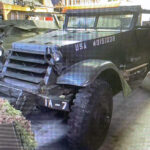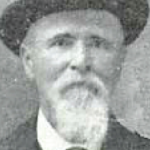

Were Confederate General Nathan Bedford Forrest and his wife buried in Munford this summer?
On Monday, July 19, a group of well-dressed men and two white hearses were reportedly seen in the back of Helen Crigger Cemetery.
Three days later The Leader found two freshly-covered gravesites under a Juniper tree with a granite bench in between them. There were gravemarkers bearing their names, but the Sons of Confederate Veterans denied they were in Munford.
“Those must be memorial headstones someone put up,” said SCV Commander-in-Chief Larry McCluney Jr. told The Leader in August. “They’re not buried in Munford.”
They were – but only temporarily – and no one knew, said Munford Funeral Home Director Brent Taylor.

Forrest’s complicated legacies
Gen. Forrest was a decorated and lauded Confederate general during the Civil War whose legacy as a slave trader and early member of the Ku Klux Klan competes with his legacy as a brilliant military strategist.
Before the war he owned a successful cotton plantation, a stagecoach company, and became one of the wealthiest men in the state trading slaves in the 1850s.
He enlisted as a private in the Tennessee Mounted Rifles and quickly rose through the ranks due to his skill leading the cavalry, especially in several key battles.
During the war Forrest was also responsible for what is called the Ft. Pillow Massacre in which hundreds of Union soldiers who’d surrendered to Forrest at Ft. Pillow were killed. Most of the dead were Black soldiers.

After the war he returned to being a planter and was a lumber merchant, railroad president, and Memphis alderman. Additionally, he joined the KKK and was elected its first grand wizard.
There is a complicated history with Forrest and the KKK. Though under his leadership the group used violence to maintain white supremacy and intimidate Black voters, Forrest called for the KKK’s dissolution in 1869 before withdrawing from the organization completely. He was said to be unhappy with group’s disorganization and, before he died, historians said he spoke about racial harmony.
Forrest’s last speech was in Covington in September 1876, where he addressed the soldiers of the 7th Cavalry, and is commemorated with marker on the grounds of the Tipton County Museum. The marker was erected in 1998 and placed on the museum grounds after it opened.

Forrest’s death and burial sites
He died in Memphis in October 1877 and was buried in Elmwood Cemetery. His wife, Mary Anne Montgomery Forrest, died in 1893 and was buried alongside him. In 1903, the couple was exhumed and reinterred in Forrest Park in Memphis, which became Health Sciences Park in 2013. The city changed the name of the park to distance themselves from controversy over Forrest’s racist legacy.
A large statue of Forrest mounted on a horse stood in the park but was taken down four years ago. Though the state historical commission does not allow cities and counties to remove war memorials from public places without permission, the City of Memphis sold the park to the non-profit Memphis Greenspace on Dec. 20, 2017 and the Forrest monument, as well as a monument honoring Jefferson Davis, was taken down that night.
The Sons of Confederate Veterans reportedly now has the monument in its possession and the plan is put it in place at the Columbia burial site.

Forrest has been a controversial figure for decades and Tennesseans have argued over how the general’s contributions to the Southern war effort should be commemorated or if they even should be because he was a slave trader and Klansman.
Nathan Bedford Forrest Day was still celebrated in Tennessee until 2019 and his bust sat in the state capitol until July 22, the day The Leader photographed the gravesite in Munford. It was moved to the Tennessee State Museum.
After years of controversy, demonstrations, protests and more, General and Mrs. Forrest were exhumed in early June with the purpose of having their remains reinterred at the Historic Elm Springs mansion in Columbia, Tenn., owned by the SCV. The property is also the home of the National Confederate Museum.
And while it was reported those remains were being held in an undisclosed location in Middle Tennessee, they were in Munford until last week.

From Memphis to Munford
Taylor was the custodian for the remains.
“I was the only funeral director acceptable to all three parties involved – the Forrest family, Memphis Greenspace, and the Sons of Confederate Veterans,” he said.
And so, on June 7, crews began the work of exhuming the couple.
Taylor said Mrs. Forrest’s wooden casket had long since deteriorated – only the metal handles remained – and her remains were lying in the bottom of the burial vault. She had to be immediately transferred into a temporary casket.
“Nathan Bedford Forrest had been buried in a cast iron casket that was in bad shape, but it was still intact,” said Taylor, noting the handles had rusted to the point where they could not get into the casket. “We had to cut into it and transfer his remains.”

The location of the remains was not disclosed, not to Forrest family members or even those employed by the funeral home. Taylor brought them into a room with street access and had the locks changed so they would not be disturbed.
He decided the Forrests needed to be buried while they waited to go to Columbia and worked with the Tennessee Board of Funeral Directors and Embalmers to determine where they should go.
The terms of the lawsuit said the remains had to be sheltered outside of Shelby County.
“Tipton County made the most sense,” Taylor said.
He also owns a cemetery in Hernando, where Forrest’s uncle lived, but the board of funeral directors agreed their remains needed to stay in Tennessee.

“I ultimately made the decision that it was best for everybody involved – everybody being the Forrest remains and my funeral home – that I simply rebury them in Helen Crigger Cemetery. [There] were two things I was trying to prevent. One, I didn’t want the Sons of Confederate Veterans every week bringing somebody – some new person high up in their organization who was passing through Memphis and wanted to come pay respects to the remains – we’d have to stop what we were doing to accommodate them. I wanted to try to prevent that. Secondly, I didn’t want the funeral home and the other families we’re serving to be the target of any protests regarding the remains being in the funeral home. So I just thought the best thing to do was to be rebury them in Helen Crigger Cemetery. I had to shelter and protect them in any way I could.”
Due to the contention that surrounds them, and to protect the gravesites of those buried in the cemetery near them, The Leader agreed to keep their burial in Munford a secret until after they’d been moved to Columbia.
The markers placed above the temporary graves gave their identities away, but Taylor said The Leader was the only call he received about the Forrests while they were in Munford. He didn’t want to bury them without a marker.
“I never want anyone to be in an unmarked grave,” he said. “I wouldn’t feel right having them be in unmarked graves.”
Tipton Countians played a part in preserving the artifacts
Other Tipton Countians contributed to the effort, even if they didn’t necessarily know it.
Jason Hambick, Taylor said, constructed a table that was a series of screens used to help filter the sludge from the bone fragments and artifacts recovered.
Munford attorney Jeff Ward drew up legal paperwork, like the affidavits detailing those artifacts.
“We had to retrieve the original artifacts, like old uniform buttons, suspender buckles, shirt buttons, hair samples,” Taylor said, noting Mrs. Forrest’s dentures and a metal hair comb were recovered from her vault.
Mickey Strickland with Strickland Construction helped preserve Gen. Forrest’s cast iron casket.
“We wanted to deliver the original cast iron casket to Columbia,” said Taylor. “They wanted to keep the rust patina on there but remove the loose rust flakes and get it ready to go on display in the museum.”

Their last interment
The National Confederate Museum agreed to have the Forrests buried there after Historic Elmwood Cemetery and three separate battlefields declined them.
According to Taylor, Elmwood said the cost of security and the maintenance of their graves would be $200,000 annually. Neither Parker’s Crossroads nor Bryce’s Crossroads, he said, felt they could provide the security needed and maintain the graves in perpetuity. Shiloh would not add the equestrian statue – the one removed from Health Sciences Park in Memphis in 2017 – which was important to the family.
And so, on Thursday, the Forrests were again disinterred.
“When we transported them to Columbia my staff member didn’t know what funeral we were on, just that he had to leave at 4 a.m. dressed in a suit. Once we got there he realized ‘Oh! It’s the Forrests!'”
Their remains were transferred into high-quality modern metal caskets and taken to Middle Tennessee where there were visitations in Chapel Hill, which is Forrest’s birthplace, and at Elm Springs before they were buried on Saturday for what everyone hopes is the last time.

Dignity and respect
All that remains of the Forrests’ temporary resting place amongst the Cooks and the Grays and the others buried at Helen Crigger is a mound of earth, the granite bench, and the Juniper trees. The markers have been moved and Taylor intends to send them to Columbia for display.
An historic event, Taylor wanted to make sure everything was done the correct way, the way that would make people on both sides of the issue happy.
“You’ve got people who think that Nathan Bedford Forrest was a military genius and hero and should be revered,” he said. “They obviously felt that he should not be removed from Downtown Memphis but ultimately agree that it’s probably better for everybody that he is relocated. So you’ve got that group that is very reverent towards Nathan Bedford Forrest.”
The other side – like those who helped organize Take ‘Em Down 901, a movement which led to the removal of the Forrest and Davis statues from public spaces – are those who do not believe Forrest’s military legacy outweighs his legacy of racism and human trafficking.
“The other side of the equation are the people who think that he should be reviled because he engaged in slave trading and many say he was brutal in war with the Ft. Pillow massacre … so there’s a group of people, reasonable people on both sides of this issue, that feel like he should be removed from Downtown Memphis and certainly should not have a statue erected in his honor in a majority African-American city.”

Taylor said it was not his place to take a side, but rather to focus on the task at hand: Removing the Forrests and keeping them safe until they could be reinterred in Columbia.
“My job was to not take a position but to simply do a job and, at the end of this process, if both of those communities feel like they got what they were looking for then I will have done my job correctly. It was important to me to do what I do every day, and that is to treat human remains with dignity and respect. My whole industry is built on that, regardless of how they may have lived their lives or positions they may have taken. That’s what I wanted to provide, not because of who Nathan Bedford Forrest was but because of what he was, which was a human being.”
He likens his job to that of a defense attorney with a professional responsibility to defend clients.
“We as a society have determined that regardless of how despicably we may think they lived their life, we have a responsibility to make sure they have a Christian burial. My job was not to pass judgement on Nathan Bedford Forrest or defend Nathan Bedford Forrest but to provide a Christian burial for Nathan Bedford Forrest and his wife. I think I’ve done that. I wanted to make sure … I treated him with dignity and respect without taking a position that he should be revered or reviled. That’s for others to sort out.”







Leave a Reply